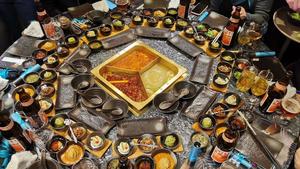 The Wangjiadu hotpot chain offers an authentic taste of Sichuan province in Beijing. (PHOTO PROVIDED TO CHINA DAILY)
The Wangjiadu hotpot chain offers an authentic taste of Sichuan province in Beijing. (PHOTO PROVIDED TO CHINA DAILY)
Besides the various kinds of Chinese hotpot restaurants, hotpot from a variety of foreign countries has taken off in China. This is a country where hotpot serves as its most popular cuisine, driven by increasingly quality-minded and fashion-conscious young consumers.
Unlike traditional Chinese hotpot, which mainly originated from Chongqing, Sichuan and Guangdong provinces, and is spicy and salty, varieties from abroad are sweet and sour. They include Japanese hotpot sukiyaki, South Korean kimchi hotpot, Thai Tom Yum Goong hotpot and Swiss cheese hotpot.
"With the expansion of China's catering market, more foreign hotpot restaurants have entered China. People who were born in the 1980s and 1990s are the main consumer groups of new-types of foreign hotpot," said Neil Wang, president of consultancy Frost &Sullivan in China.
"The rising spending power and diversified demand from young people have become the new driving force for foreign hotpot. More developed first-and second-tier cities are the prior choices for foreign hotpot operators. With the continuous pursuit of innovation by fashion-conscious Chinese consumers, demand for foreign hotpot is likely to grow in China," he said.
Japanese hotpot is the most popular among foreign hotpot dishes in China. Japanese hotpot restaurant Izu Vegetable Hotpot now has eight branch restaurants in Beijing.
The hotpot buffet contains a large variety of meat, sushi, sashimi, vegetables and deserts. It provides multiple hotpot base flavors such as sukiyaki, soybean milk and curry, the restaurant said.
The brand also launched its first overseas store in Sydney in 2018.There are usually long lines of people waiting outside the restaurants, despite the fact it limits the buffet eating duration to no longer than 100 minutes.
In Hangzhou, Zhejiang province, a single-friendly Japanese hotpot restaurant that targets individual diners has attracted a large number of single customers. It offers small portions of food and single seats for individuals. The restaurant opens at 11:11 am and closes at 10:22 pm, symbolizing the idea of going to the restaurant alone and leaving with a companion.
On Dazhongdianping, a Chinese customer-rating app that is similar to Yelp, there are hyperlinks to more than 600 Japanese hotpot restaurants in Beijing.
Most consumer reviews are positive about the experience of dining out at such places, which offer a cozy environment for diners willing to wait in long lines.
Swiss melted cheese fondue is something new in China, and there are few such restaurants in the country. Eaten by dipping bread into cheese using long-handled forks, many Chinese cheese lovers have said they like the cuisine, but others are not yet convinced.
With less recognition and relatively lower acceptance of cheese by Chinese consumers, Swiss fondue is still a niche market in the country.
By 2022, sales in the hotpot sector are expected to reach 800 billion yuan (US$116.3 billion), given its high acceptance and unique taste. In major first-and second-tier cities, there is still room for further expansion while in smaller cities, the room for growth is significant, said a research report by China Securities.
"More new types of hotpot are colliding with traditional hotpot culture. With rich kinds of base materials and seasonings, traditional hotpot still has high customer stickiness. Meanwhile, beautifully presented hotpot and special food ingredients have ample room for growth in China," the report said.
At this time, traditional Chinese hotpot, such as Sichuan-style, Guangdong-style and Inner Mongolia-style hotpot, has taken a dominant share of the market. It accounts for more than 90 percent of market share, with foreign hotpot taking the rest.
"In the increasingly competitive Chinese hotpot market, where there are a number of new emerging Chinese types of hotpot such as hotpot with pork tripe and chicken, and congee hotpot, foreign styles need to consider how to raise their brand image and values, and improve the taste to better cater to local appetites," Wang said.
He added that many Chinese consumers who were born in the 1960s and 1970s still prefer Chinese hotpot, and their acceptance level for foreign hotpot is lower than young people. Foreign hotpot operators should think about how to further develop their growth potential in those consumer groups.


